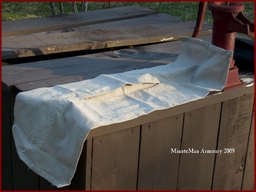-
Posts
9,309 -
Joined
-
Last visited
Content Type
Profiles
Forums
Events
Gallery
Everything posted by William Brand
-
Boats in a harbour and a yacht sailing away, also known as Harbour mole of Texel by Willem van de Velde the Younger, 1673. Lots and lots of big hats!
-
The Frigate "De Ploeg" on the Ij in Amsterdam by Ludolf Bakhuizen (ca. 1685-1695) This one has excellent baskets in the boat to the right.
-
I've recently discovered some amazing paintings of the Golden Age and earlier and thought I should share them here... First... ca. 1688 - Dutch Whalers off a Rocky Coast by Abraham Storck Second... 1653 - The Battle of Livorno (De zeeslag bij Livorno 14 maart) by Reinier Nooms 1660 - The Battle of Livorno (Leghorn) by Johannes Lingelbach Slag bij Livorno (Battle of Leghorn) by Willem Van de Velde the Elder
-
Day 43: 1689 - The Humble Address. Called 'The Humble Address' the full title is 'To the King and Queen's Most Excellent Majesties. The Humble Address and Petition of the Governour, Council, and Convention of Representatives of the People of Your Majesties Collony of the Massachusetts, in New-England'. This one is on a letter sized page and 1.25" should be trimmed off the two sides after printing. Remember, you don't have to cut straight lines on period documents. The printing is often off-centered and cantered to one side or another and pages are not trimmed square. 1689-TheHumbleAddress.pdf
-
DAY 40: This is one of many plates by Mallet and it features Cuba and Jamaica. I set it up on an 11" x 17", but I may offer a smaller version later if I can confirm the original size. PoD found that the original imprint area is aprroximately 4"x6" so I've redone the pdf with two up on a letter sized page with crop marks. Thank you! 1683-CubaAndJamaica.pdf
-
Amazing stuff!
-
Short answer. I have no idea. Long answer. I've heard speculation from pumps to buckets, but never piss tubs. There are many examples of 'fire restrictions' and I've seen several documents that talk about the snapping of anything that will cause a spark and the limitations of smoking and lanterns in various parts of the deck. The tradition of smoking forward is still strictly observed by captains even today. A careless pirate aboard the Liberty Clipper at Pirates in Paradise allowed her cigarette to be carried into the rigging while smoking amidships. The captain placed the lady in the brig 'verbally speaking'. You become very aware of fire when surrounded by canvas and wood powered by wind.
-
That coffin is hideous. Funny, but hideous.
-
Are there merchants that make that sort of thing today?
-
That looks like a straw tricorn, either on purpose or by accident. I suppose it could be an old hat that has just been 'tricorned' by abuse over the years. What year is the painting?
-
What!!!? Captain Jim is superior to that fellow in every way. How dare you compare our captain (who will never accept his captaincy) with the man!
-
Straw. That's my immediate impression.
-
The double bell wedge is a pretty tent, but it does come with some challenges of you want to put a rope bed in it. John Gallia (CaptJ) has one. I think the delux storage tent by Red Hawk Trading Company is nice. It's a very deep storage tent with a full awning. Think about Hugh's giant tent setup minus the second side. http://www.redhawk-t...torage-tent.htm
-
-

Joyeux Anniversaire Margot La Mechante!
William Brand replied to Stynky Tudor's topic in Scuttlebutt
Soulevez un verre. -
Mark is hereby pardoned, but in all seriousness...fantastic stuff. You've done yourselves and the hobby at large very proud.
-
Someone promised pictures and I've seen only a handful. Who's to blame?
-
Just tell him to make a green or brown justacorps.
-
Those are fun.
-
The sword fight (and dialogue) between Stewart Granger and James Mason in The Prisoner of Zenda.


